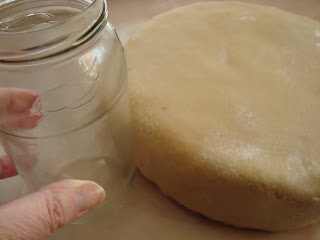I always make 1 lb of shortcrust pastry (A ratio of half fat to flour) at a time and use it to make various things. Occasionally, I will only use half of it and freeze the remainder; it freezes extremely well.
Ingredients
1 lb S R Flour (plain is recommended in many recipes but I prefer the lighter pastry this makes)
Good pinch of salt
4 oz hard butter
4 oz lard
Cold water
Method 1
Put all the ingredients, except the water, into a food processor and blitz until it resembles breadcrumbs.
Slowly add some cold water until the mixture binds.
Turn out onto a floured work top and make into a ball.
Wrap in clingfilm and chill in the fridge for at least half an hour.
Method 2
Put the flour, salt and fats into a large bowl.
Using your fingertips gently rub the fats into the flour until it resembles breadcrumbs.
Add a little cold water and bring everything together using a knife.
Turn out and make into a ball and chill as above.
Today I made 18 mincepies, 1 quiche and a tray of bakewell slices with this amount of pastry. All of these recipes are delicious eaten fresh or they freeze well for the coming weeks. I will freeze half of the almond slices and a dozen mince pies.
Mince Pies
Roll out the pastry thinly and, using a cutter, cut out circles to fit bun/tart tins.
Put 1 teaspoon mincemeat into each pastry.
Use the remaining pastry to cut out lids for the mince pies. I like to use a star cutter at this time of year. If you choose to put a circle on top use a smaller cutter than
used for the base and dampen the edges to make it stick to the base.
Bake at 200C for five minutes then reduce to 150C for approximately ten minutes.
Cool on a wire rack and then sieve icing over the top.
Serve warm with clotted cream or creme fraiche.
Delicious mincepies, fruity and spicy. Enjoy!
Almond Bakewell Slices.
The recipe for these can be found on my July blog.
 |
| When cold cut into fingers or squares |
Tip: Use a rolling pin to lift the pastry onto a baking tray or tin.
Roll the pastry over the rolling pin, hold it over the tin or baking tray and gently unroll. Easy!
Quiche.
Shortcrust Pastry
Cheddar and Double Gloucester Cheese
2 large free range eggs
Half fat creme fraiche
Little milk
Cayenne Pepper
This is a 'use up' quiche.
Use the remaining shortcrust pastry to line a sandwich tin.
Grate the cheeses and cover the pastry base generously.
In a bowl, mix the eggs, creme fraiche and a little milk until blended.
Pour the mixture over the cheese.
Sprinkle the surface with a little cayenne pepper.
Bake 200C for ten minutes then reduce to 150C until the quiche is well risen and golden on the top.
Leave to rest for ten minutes before cutting.
 |
| The cooked quiche |
This freezes well, if cooled first.















































